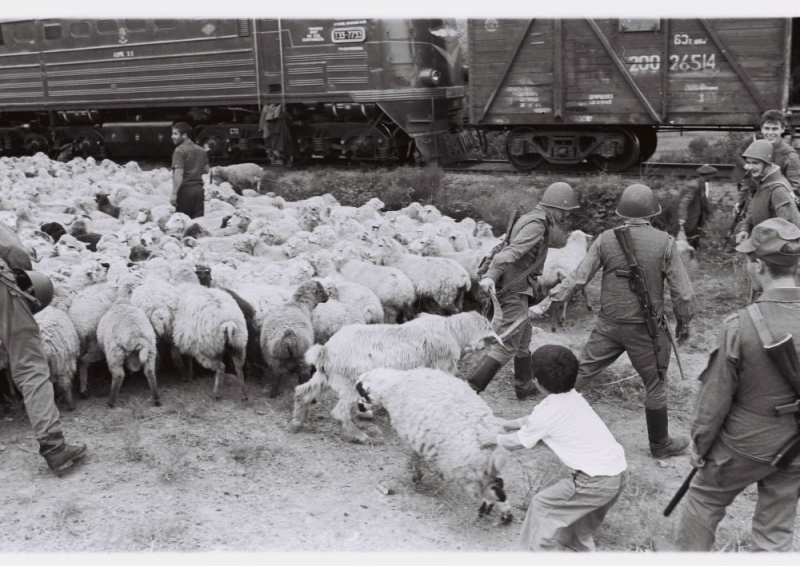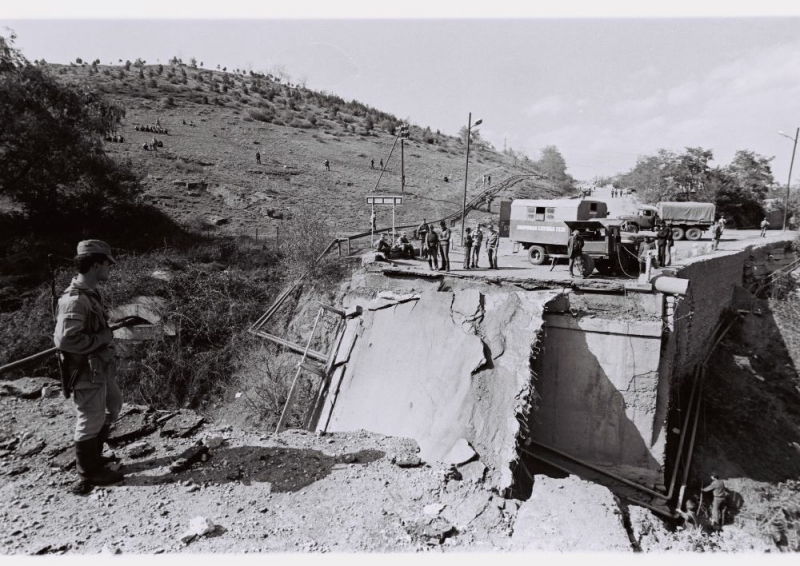
It has to be kept in mind that Pashinyan availed of this argument in the course of debates on the Karabakh resolution with Azerbaijani President Ilham Aliyev at the Munich Security Conference.
It is worth pointing out that Mutalibov had immediately denied these allegations. In turn, a Czech journalist, Dana Mazalova published an interview with Mutalibov on April 2, 1992 in the Russian «Nezavisimaya gazeta » as claiming that Mutalibov reaffirmed the fact though she failed to adduce a proof lost after all this time.
It will suffice to mention that Mutalibov insists that he dealt with Hojaly in the light of struggle for power between the ruling Communist elite and the People’s Front and that the opposition availed of the tragedy to give him the sack.
In this respect Mutalibov is right but it ought to be noted that the then authorities and the opposition and the whole nation were responsible for the Hojaly tragedy, Karabakh crisis and hundreds of depopulated and burnt villages across the whole perimeter of the Armenian-Azerbaijani border.
Subsequently, the struggle for power in Baku resulted in the occupation of country’s 20 % territory by Armenians. Note that the struggle has not ceased even up to this day to thus fuelling threats of country and people’s security. But this is a topic of another article.
Now I get to Hojaly point
The Armenia party holds that it left a security corridor for residents of the town to leave it with access to Agdam. First, a question arises: Why was it necessary to leave a corridor for peace residents that threatened no Armenians. It is worth pointing out that a small self-defense detachment was located in the town. However, this detachment had no heavy offensive armament threatening security of the Armenian populated localities around Hojaly.
The essential point to remember is that even if the Armenians would have taken such a decision within the framework of its policy of ethnic cleansing, they had had то achieve this goal, make an appropriate agreement and finally secure a safe corridor with the help of 366th Russian regiment quartered in the region with a view of ensuring the security both of the Azerbaijani and Armenian parties. Regretfully, it was this regiment that proved to be an accomplice to the destruction of the town and the extermination of its residents.
It must be borne in mind that by 25 February all Azerbaijani-populated points of Nagorno Karabakh, except for Shusha had already been depopulated due to the consecutive Armenian policy directed to ethnic cleansing of Azerbaijanis that practically was implemented first on the territory of the Armenian SSR and then in Karabakh and adjacent Azerbaijani territories.
Account has to be taken of the fact that the blockade of Hojaly and other Azerbaijani populated localities started much earlier than it expected to be. That was prefaced by a long-term creeping aggression of Armenia within the framework of undeclared war, well thought-out strategy which was underestimated both by official authorities and squares of Baku.
Two years before tragedy
In November 1989 I arrived in Karabakh to prepare on-the-spot report on current developments in the region together with photojournalist Farid Khayrulin. We worked as «Azerinform» (now Azertaj) TASS-bureau correspondents, military-legal department and related security issues formed a part of my job description as a correspondent.
We arrived at Agdam where a Russian military garrison was headquartered (its military personnel came from Russia). In virtue of our duties we were familiar with Russians, so we headed for them to acquaint with the situation and concurrently resolve a purely regional issue. The question was that a large herd was returning from pastures to Agdam but turned locked in Hojaly already been blocked by Armenians on the part of Askeran. Note that this town was located on the path between Hojaly and Agdam.

Karabakh. Khojaly. 1989. Photo: Farid Khairulin
Under this circumstance it was decided to carry the herd by means of freight cars; however, it was rather dangerous without the military support. Availing of personal liaisons with the military and producing out TASS certificates, jointly with Khayrulin we managed to convince a commandant and his deputy of the necessity of ensuring security of the operation. On infantry fighting vehicle we headed for Hojaly.
While at Hojaly, local residents complained at inimical actions of Armenians that actually blocked up the town’s population cutting all roads and shooting it at night-time from tommy guns and rifles with the connivance of demoralized Russian militia in charge of law enforcement. Note that hunting shotguns were withdrawn from all Azerbaijanis on the instruction from Baku. Without giving specifics of that day and a fun fact that nearly cost of Khayrullin’ life, but all the herd of couple hundreds of sheep was loaded into a freight car and, accompanied by infantry fighting vehicles, delivered to Agdam.

Karabakh. Unlocking the Road to Shusha. 1989. Photo: Farid Khairulin
A day later accompanied by the Soviet (Russian) military we were carrying foodstuffs to blocked Shusha. Our army convoys were closed off by Armenian men and women along the road who shouted anti-Azerbaijani slogans. We had to fire into the air and thus clear the way. Finally we arrived in Shusha and unloaded. On the way back we were stoned, our ZIL tents holed in some placed.

Karabakh. Aga korpyu bridge. 1989. Photo: Farid Khairulin
Next day, on November 7 together with Khayrulin on a Russian armored vehicle we came to the bridge Aga kerpusu which was blown up by Armenians at night to thus block a road to Shusha. A single road laid via Lachin on the border with Armenia. However, the situation in the area was going from bad to worse.
Border-zone
Jointly with Deputy Internal Minister Ramiz Mamedov we arrived at Lachin and settled in a room of the first party secretary. Two militiamen came in, and a lieutenant reported: Armenians are firing on a border village of Yuhary Jimjimli. Asked by Mamedov, why don’t you retaliate? – He replied: we have just «Makarov» pistols with impact zone of 50 meters. – But where are tommy guns? – Deputy Minister asked. – We are not armed with tommy guns, lieutenant said.- we’ll give it to you, Mamedov noted (Later on I learned that no tommy guns were delivered). – Mamedov phoned, and at night a Russian garrison soldiers taped Armenians. I arrived on the scene in the morning, canvassed locals and militiamen, as well as photographed a roadblock, cartridge-cases, blood of the wounded or killed Armenians taken away from the crime site.
It has to be kept in mind that the tactics of round-the-clock shelling and attacks on unarmed population was aimed at forcing people out of their family hearths and birthplaces. From Lachin, together with Mamedov we headed for Gubatly where Armenian militants kidnapped a head of local village council. Reportedly, he was taken to Armenia and killed after tortures. Mamedov was to meet with Deputy Internal Minister of Armenia on a boundary Goris road and discuss a question of the dead body’ return.
On the way from regional center Gubatly to the Armenian border we witnessed depopulated villages in 1989! Passing by a village we saw a lorry with household items on. We thought that these were marauders but proved to be locals. It transpired that on nights the Armenians opened fire on the village, it became intolerable to remain here, a lad said. Why don’t you try to slap them down? We have no arms, he replied. When we drove by neighboring villages, a head of rural militia department with a tommy gun in his hand felt interest in the names of villages. In the meantime, he worked here for 2,5 years?!
A day later, together with an internal unit from Altai region we tried to disrupt attacks of Armenian forces on a mountain village of Aliguluushagi. Also, locals attempted to defend themselves with hunting shotguns. At night the Armenians are launching attacks on the village. No retaliatory fire is opened, no arms are available.
By the time of the Hojaly tragedy all human settlements with Azerbaijani population were depopulated in Karabakh (except for Shusha) together with most villages in border districts. It should be noted that before the occupation of the said regions the Armenians had set depopulated villages ablaze. Suffice it to recall that 14 cross-border villages were burned to ashes in Zangelan region.
All of us are to blame
Getting back on Hojaly and Mutalibov topic, I can attest as a man in charge of everyday chronicle of Azerbaijan in the pre- and post-dissolution period of the USSR that all of us were responsible for the 30-years tragedy: in the first turn, then authorities; second, the opposition (reversed roles); third, all of us (in loco). As for the Armenian party, it pursued its policy in strict adherence to the plan; however, its organizers and instigators made no bones of the fact that the victory proved to be Pyrrhic. An eloquent testimony to this was Pashinyan’s statement in Munich.





















Leave a review